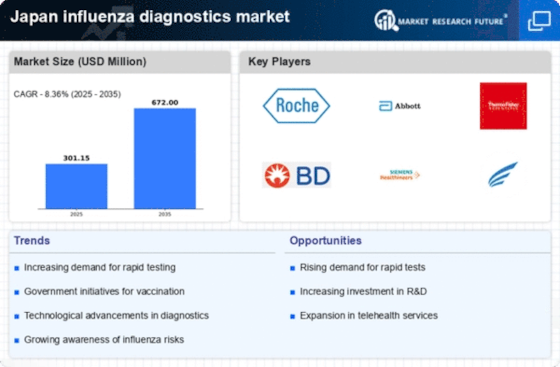Rising Incidence of Influenza Cases
The rising incidence of influenza cases in Japan is a critical factor influencing the influenza diagnostics market. Seasonal outbreaks have become more frequent, prompting healthcare providers to seek effective diagnostic solutions. In recent years, the number of reported influenza cases has shown an upward trend, leading to increased testing and diagnosis. The market is expected to expand by 9% in 2025, driven by this rising incidence. As healthcare systems strive to manage outbreaks effectively, the demand for accurate and rapid diagnostic tests is likely to surge. This trend underscores the importance of timely diagnosis in controlling the spread of influenza and highlights the growing reliance on diagnostic services.
Increased Awareness of Influenza Risks
The heightened awareness of influenza risks among the Japanese population is a crucial driver for the influenza diagnostics market. Public health campaigns and educational initiatives have emphasized the importance of early detection and timely treatment of influenza. This awareness has led to a growing demand for diagnostic tests, as individuals seek to confirm their health status promptly. In 2025, the market is projected to witness a growth rate of approximately 8% due to this increased awareness. Furthermore, the emphasis on preventive healthcare in Japan aligns with the rising trend of self-testing, which is likely to further boost the influenza diagnostics market. As more individuals recognize the symptoms and seek testing, the market is expected to expand significantly.
Advancements in Diagnostic Technologies
Technological innovations in diagnostic tools are transforming the influenza diagnostics market in Japan. The introduction of rapid testing kits and molecular diagnostics has enhanced the accuracy and speed of influenza detection. These advancements allow for quicker results, which is critical in managing outbreaks effectively. In 2025, the market for molecular diagnostics is anticipated to grow by 12%, driven by the demand for precise and timely testing solutions. Additionally, the integration of digital health technologies, such as telemedicine and mobile health applications, is likely to facilitate easier access to diagnostic services. This technological evolution not only improves patient outcomes but also supports healthcare providers in managing influenza cases more efficiently.
Focus on Preventive Healthcare Measures
The emphasis on preventive healthcare measures in Japan is significantly impacting the influenza diagnostics market. With a growing recognition of the importance of early detection and prevention, healthcare policies are increasingly prioritizing diagnostic testing. This focus is reflected in the rising adoption of routine screening and vaccination programs, which are designed to mitigate the impact of influenza outbreaks. By 2025, the market is projected to grow by 11% as preventive measures gain traction. The integration of diagnostic testing into public health strategies not only enhances disease management but also fosters a culture of proactive health monitoring among the population. This shift towards preventive healthcare is likely to drive sustained demand for influenza diagnostics.
Growing Investment in Healthcare Infrastructure
The ongoing investment in healthcare infrastructure in Japan is a significant driver for the influenza diagnostics market. The government has been allocating substantial funds to enhance laboratory facilities and diagnostic capabilities. This investment is expected to increase the availability of advanced diagnostic tools across various healthcare settings, including hospitals and clinics. By 2025, the market is projected to grow by 10% as a result of improved access to diagnostic services. Enhanced infrastructure not only supports the timely diagnosis of influenza but also strengthens the overall public health response to seasonal outbreaks. As healthcare facilities upgrade their capabilities, the demand for reliable diagnostic solutions is likely to rise.

















Leave a Comment